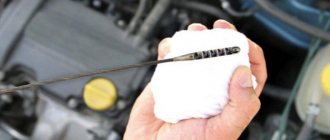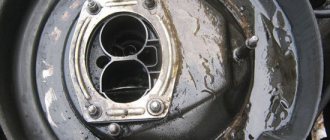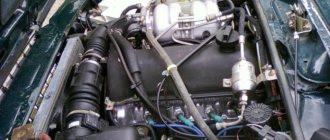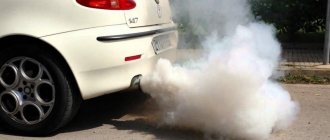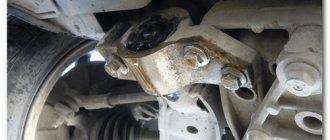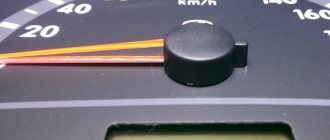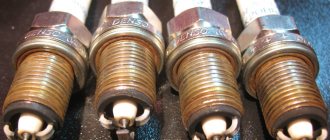The smell of gasoline appears in the car interior for various reasons, mainly related to a malfunction of the fuel system. To eliminate the pungent odor, it is necessary to prevent fuel leakage. This is especially important to do as a malfunction can lead to a fire.
ina.
All elements of the car’s fuel system are located along the length of the body - this was designed specifically for safety. The gas tank is placed away from the engine, in the rear of the car, to reduce the risk of explosion.
There are, of course, disadvantages to such a fuel system: the gas line is very long and it uses many connections and wiring. Most often, fuel leaks occur exactly where it is stored - that is, from the gas tank or other element that is located on or near it. You need to know how to eliminate such dangerous leaks.
The main causes of odor in the car interior:
Since the bulk of the fuel is located in the tank, the search must begin there. Perhaps it is simply worn out or rusted.
The tank can hold up to 100 liters of fuel, so the weight when full can be very large, resulting in a lot of stress on the mountings. Most often, the tank is suspended from the body, and the suspension looks like curved iron strips that are evenly spaced under the bottom of the tank.
These strips are attached to the body using high-strength bolts, and, ideally, the tank should not move, but during driving, due to high vibration, it often rubs against the body of the car. The designers of the VAZ2110 thought about this, so they installed special rubber gaskets between the tank and the car body, but with intense and extreme driving, these gaskets slowly wear out, and therefore the tank begins to move a little, which leads to rubbing of the tank.
Advice: Periodically inspect all elements of fuel equipment and gas lines, as your safety depends on it.
The tank may also rust due to low-quality metal or fuel. This mainly happens in old cars and cannot be restored. If the tank on your car is worn out or rusted, then you need to change it immediately, and for prevention, monitor the tension of the tank fastenings more often.
This is the second weak point. The neck is attached to the tank using a special gasket and bolts, as well as by welding. The latter method is less reliable because the welds are often destroyed - a bolted neck will last longer, even when the tank swings violently in different directions.
Therefore, when the smell of gasoline appears in the interior of a VAZ, the welding seams on the tank should be checked first.
It should fit snugly to the neck, gasoline should not leak from under it, so monitor the condition of the gasket.
The lid also has a special valve through which gasoline vapors are released when the pressure in the tank increases (in summer). But due to wear of the gasket, the vapors will freely escape into the atmosphere. Basically, in modern cars, the neck of the tank is recessed into the car body and is closed with its own lid and on top with a hatch cover; as a result, when the gasket wears out, vapors enter the cabin and not outside.
If the gasket under the tank cap is in good condition, then you need to continue searching for the leak further. If the gasket is dry or cracked, the cover must be replaced.
- Fuel pump manhole cover
There is another rather vulnerable place in the tank - this is the cap to which the gas pump located in the tank is attached, this applies to modern cars, such as the VAZ2114.
The fuel pump cover is attached to the tank using bolts. There is also a rubber gasket under the cover, which is the weak point of the structure. This gasket is exposed to gasoline, which quickly destroys the rubber.
Advice Experienced VAZ 2109 car owners recommend that if there is a smell of gasoline in the cabin, first of all, check the entire gas line for leaks, starting from the area under the rear seats and reaching the carburetor. However, if the car smells not of gasoline itself, but of exhaust gas, then special attention should be paid to the seals of the lights and rear doors.
If the fuel pump breaks down and the cover is removed and placed unevenly, the gasket may break or fail to fit tightly. In this case, it does not create the necessary tightness of the connection, which is why fuel leakage occurs. A torn or worn gasket must be replaced. You need to make sure that the lid is level.
Valve for the system of releasing gasoline vapors from the gas tank. Most often, a special valve is placed on the gas pump cap to release gasoline vapors from the gas tank. The valve has a pipe onto which a hose is placed—it is through this that gasoline vapors enter the adsorber tank. During the operation of the car, this rather fragile pipe may break, resulting in a leak, and as a result, there will be an unpleasant smell of fuel in the car interior. To get rid of this you will have to change the valve. Such a breakdown is especially typical for injection vehicles, including the VAZ2107 model.
- Fuel line (clamps, pipes)
In the fuel line, elastic hoses are used in moving places, which can fray when driving on uneven roads, and the clamps on them can become loose at the joints. Because of this, gasoline will begin to escape through them, which will lead to the penetration of fuel vapors into the cabin. And this is the most common reason for the smell of fuel in the car interior.
As a result of incorrect adjustment of the carburetor, the fuel will overflow, and gasoline vapors from under the hood will penetrate into the interior of the car. This does not apply to injection machines.
How to eliminate the smell of gasoline in the car interior?
Gasoline vapors can appear in the cabin for many reasons, but there are few effective ways to solve this problem. Below are the most common ways to get rid of this difficult problem.
- Weathering. This method of elimination is the most effective; it allows gasoline vapors to quickly dissipate. If the smell in the cabin appears in the summer, then you need to open all the doors, as well as the trunk, to create a draft. A fan can be used to speed up this process. If you smell gasoline in winter, turn on the heater at full power and open the rear and front doors alternately to ventilate the interior. Weathering will be useless if there are problems with the tank, as it needs to be replaced.
- Adsorption of gasoline vapors. To eliminate odor, you can use caustic soda, activated carbon, silica gel and natural coffee. One of these products is sprinkled on a gasoline stain. After three days, the product can be removed, but before you remove the absorbent, you need to prepare a rag and detergent to wash off any remaining gasoline. The seats and instrument panel must be wiped with a damp cloth. If you cannot get rid of the smell of fuel the first time, then you need to repeat the procedure.
- Washing car upholstery. If you want to eliminate the smell of fuel in the car yourself, you need to add lemon juice to the washing water, as well as a spoonful of regular baking soda. However, this method is quite labor-intensive and does not guarantee that the smell will be eliminated.
- Car wash. Many car owners do not always have free time, so they solve the problem with the help of a car wash and dry cleaning. Experts select special products to completely eliminate the smell of gasoline in the cabin, as well as to wash gasoline stains. In addition, they can ozonate the interior. This will take 20-30 minutes; if the smell does not disappear, then ozonation can be repeated.
Important Before trying to remove the smell of gasoline from the interior, you need to eliminate its cause, and to do this, eliminate breakdowns in the fuel system or faulty seals on doors, headlights, and other parts of the car.
To clean the interior of gasoline stains, the Miss Clean website advises using high-quality detergents, and in difficult cases, contacting specialists at car washes.
Each driver takes care of his vehicle and pays special attention to any problems. An unpleasant odor inside the car can often be a cause of concern. If you smell gasoline or burning, this is the first sign of a malfunction in some vehicle systems. So why does unpleasant odor occur and how to eliminate it?
Absorber and company...
The absorber is a whole structure, which is designed to prevent expanding fuel and its vapors from inflating or rupturing the gas tank. But environmentalists and other “greens” do not allow gasoline vapors to be released into the atmosphere just like that. They “forced” the designers to introduce things into cars that could purify gasoline vapors and not cause irreparable harm to the environment.
The structure of the classic absorber is very simple. This is a plastic or metal box, inside of which there is a carbon (usually) filler that acts as a filter. Gasoline vapor from the tank enters here through a tube that fits onto the fittings.
The absorber can become the “culprit” of the smell in the car interior for several reasons:
- the carbon filter has already served its purpose;
- there is a leak at the hose connection points;
- for some reason the branch pipe of the ventilation branch has become bent and no longer allows vapor to pass through it;
- blockage in the gas tank ventilation system.
This problem is quite easy to diagnose and fix. It is quite possible to do without specialists. You should look for the absorber somewhere in the lower rear part of the car near the gas tank itself. In some cars it is “hidden” under the wing. The part is dismantled, cleaned, washed, checked for leaks and reinstalled. If after dismantling it becomes obvious that it will not work, replace it.
The smell of burning
When driving a personal car, many drivers note a burning smell in the cabin. There are many reasons for this phenomenon. Some of them can be eliminated on your own, while others can only be eliminated with the help of specialists.
- The smell of burning in the car interior may come from the street. In this case, you can turn on recirculation. There is also a possibility that the cabin filter has simply become unusable.
- An unpleasant odor can occur as a result of heating dirt that has adhered to the engine or exhaust system. A similar phenomenon occurs with almost every car. This is especially true in the off-season, when there is slush on the roads. The problem can be partially solved by washing the engine. But it is unlikely that you will be able to get rid of the stuck dirt on the exhaust. If, even after the engine has been washed, there is a smell of burning in the car interior, then in this case only recirculation will help. The whole problem lies in the design features of the vehicle.
- Often, an unpleasant odor in the car interior occurs as a result of oil leakage from the engine. During operation, the liquid burns. The problem usually lies in the valve cover gasket. In some cases, it is enough to simply replace it.
- The burning smell can also be caused by some problems with electronics. This is a fairly serious problem that can lead to a fire. Therefore, it is worth seeking the help of specialists for a complete inspection of the vehicle and troubleshooting.
- Another reason why there is a burning smell in the cabin is a violation of the integrity of the gasket located between the muffler and the exhaust pipe. In this case, it needs to be replaced.
Viburnum berry - medicinal properties
Viburnum berries
Under my window at home grows a beautiful common viburnum, brought with a small twig from Ukraine 15 years ago. It has grown into a huge beautiful bush, blooms wonderfully in the spring, delighting those around with its beauty, and in the fall it is strewn with clusters of red berries. During flowering, bees and bumblebees buzz above it, diligently pollinating many inflorescences. In winter, bright flocks of waxwings fly to the remains of the berries to feed. Once I was able to observe such a flock: they flew in, merrily pecked all the berries in a couple of hours and flew away. The soul rejoices!
And many people know what a useful medicinal plant this is! Viburnum has always been considered a magical tree by healers and healers. It especially helps women. Even just touching leaves or branches, a woman feels relief of her state of mind and calmness. In ancient times in Rus', this beautiful plant was a symbol of love. Berries and bouquets of viburnum flowers were placed on the wedding table.
Viburnum in autumn
Fuel system features
Almost any fuel cell can become unusable. As a result, an unpleasant odor will appear. Inspecting the car should start with weak points.
The fuel system elements are located along the entire length of the body. This is done for greater safety. Thus, the fuel tank is located at a safe distance from the engine, which can become very hot during operation. In addition, the vehicle’s engine is entangled with electrical wiring through which current flows into various compartments. Of course, it’s no secret that the fuel tank is precisely the part of the car that poses a potential danger.
In the engine compartment, as a rule, there is a minimum of gasoline, which is necessary for the normal operation of the car. However, this system layout also has some disadvantages:
- Fuel line too long.
- Availability of various types of connections.
In most cases, or rather in 90 percent of all, fuel leakage occurs precisely from the gas tank or from its elements that are attached directly to it or located nearby. But there is more fuel here.
Filler neck in the tank
The weakest point of the fuel tank is the filler neck. Problems with this part can lead to the smell of gasoline in the cabin. The filler neck can be welded or screwed to the fuel tank using a rubber gasket. The latter fixation option is considered more reliable. If damaged, the welded joint can quickly fail. But the gasket and flange will last quite a long time.
If the car interior smells like gasoline, then first of all you need to inspect the welded joint. If there are defects, they should be eliminated.
Treatment with viburnum
As an example, I will give a few simple recipes for treating viburnum from the encyclopedia “Secrets of Traditional Medicine”.
Everyone enjoys this plant, but they just don’t like the smell, especially men. The fruits, in addition to being bitter, have a specific smell, similar to the smell of dirty socks. When I open a jar of jam, the spirit spreads throughout the house and people around me say “eww.” Large flat bones also strain. But it’s tasty and healthy!
If you grind fresh viburnum berries with sugar, you hardly notice the smell, and the vitamins are better preserved. In the fall, my parents made the preparations this way and store them in the refrigerator. Now everyone is happy to eat mashed berries, but they don’t want to eat jam. So I recommend this method.
Kalina at home
Fuel pump manhole cover
The car interior should not only be clean, it should smell nice. However, this is not always possible to achieve. There is another weak point in the fuel system - the cover that holds the fuel pump with fuel level sensors in one module inside the tank. This part is usually secured with screws that are threaded through holes drilled along the contour. Under this cover there is a rubber gasket, which is often the weak link. This part is constantly exposed to fuel vapors. After a certain time it simply collapses. As a result, the seal is broken, resulting in the smell of fuel in the cabin.
Regular coffee
Eliminating car odor can sometimes be a difficult task. For these purposes, you can use regular ground coffee. It is enough to cover gasoline stains with it. Why ground coffee?
This product contains a large amount of oils that absorb other odors. Of course, you can also use freeze-dried coffee. The sprinkled stain should be left for seven days and then washed again. It is not necessary to use an expensive product. You can buy a bag of cheap coffee.
Viburnum viburnum - beneficial properties
The beneficial properties of viburnum have been known for a long time and have been actively used in folk medicine. The bark, flowers and berries are considered healing. Viburnum berries contain two to three times more iron than other berries! The bark has an astringent, anti-inflammatory, hemostatic effect, and even relieves tension in the uterine muscles during childbirth.
Substances contained in the fruits improve heart function, heal wounds, relieve inflammation, and have a choleretic and diuretic effect. The fruits are especially useful for people recovering from a serious illness. Juice from viburnum berries helps in the treatment of skin diseases. Flowers are used for colds.
Common viburnum, winter
Dish detergent
Gasoline is a chemical oily product. To remove fuel stains, you can try using dishwashing detergent on them. After all, such liquids have a special chemical composition that allows you to quickly break down fats. In addition, dishwashing detergent necessarily contains fragrances and fragrances that help get rid of unpleasant odors.
It is enough to pour a little liquid onto the fuel stain and wait until it is absorbed, and then carefully rinse with water. If the contamination is large, it must be removed in several approaches.
Why does the car interior smell like gasoline?
The key stage in dealing with this problem is to find out the cause of the unpleasant smell of fuel in the car interior. As practice shows, any make of car smells of gasoline if there are faults in the fuel system components.
The gas tank elements are located far from the engine, along the entire perimeter of the car body, which reduces the likelihood of ignition. But such a length of the gasoline supply line increases the risk of leakage.
There are several reasons why the smell of gasoline appears in the car interior:
- Hole in the gas tank. Sometimes, due to constant driving on bad roads, the tank mounts become loose. As a result, the container moves and rubs against the car body. Over time, a hole forms in this place from which a flammable mixture flows. Metal corrosion also contributes to the formation of a hole in the tank. This problem can be solved at a service station, where a technician will patch or replace the gas tank.
- Wear of hoses. Over time, fuel hoses crack or wear out, leading to fuel leaks. Sometimes the interior smells of gasoline due to improperly attached or loosely tightened fuel pipes. As a result, fuel leaks through the clamps.
- Damage to the filler neck. When the smell of gasoline is very unpleasant, the driver should first check the filler neck connected to the fuel tank by welding. Regular driving on bad roads and weakening suspensions are key causes of leaks in the welding area. To extend the service life, you need to screw the neck with bolts or special gaskets.
- Faulty gas cap. Often a leak occurs due to a lack of tightness in the tank lid. In such situations, the part needs to be replaced.
- The fuel pump is functioning at a low level. Breakdown or contamination of this unit, as well as rupture of the membrane in carburetor cars, leads to fuel leakage.
- Clogged filters. The smell of gasoline in the car interior may occur due to dirty fuel filters.
- Incorrect carburetor adjustment. Malfunctions and incorrect settings of the carburetor system are accompanied by excessive consumption and leakage of gasoline.
- External factors. Often, an unpleasant smell of fuel is caused by reasons not related to technical problems: the air intake absorbs gasoline smell from a car moving in front, spilled fuel in the cabin, etc.
Important! Next to the right door is the fuel filler hatch. Therefore, if the door seals are worn, fuel vapors can penetrate into the car interior from the neck. Replacing the seals will solve this problem.
Sometimes the smell of gasoline in the car interior appears when the engine is started and evaporates after a while. In the event of a cold start in winter, the electronic control unit supplies a rich mixture, after which the driver temporarily smells unburned gasoline from the exhaust pipe. This is normal. If an unpleasant smell of fuel occurs and persists constantly when starting a warm engine, then the reason may lie in a broken fuel line, faulty sensors or injectors.
It should be remembered that inhaling toxic gasoline fumes is often accompanied by headache, nausea, dizziness and even loss of consciousness. In addition, even a small spark when interacting with gasoline vapors leads to ignition and explosion of the car. Therefore, if you notice a smell of fuel in the car’s interior, you should immediately contact the service station specialists if you are unable to find the cause on your own. Experienced service station technicians will install the catalyst for the problem, eliminate faults and replace the necessary parts.
Important! When it comes to a domestic brand of car, for example, the VAZ model, in most cases the smell of fuel in the cabin is due to the poor functioning of the old ventilation system.
